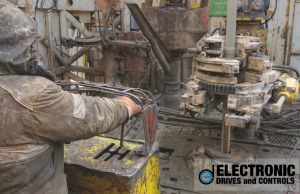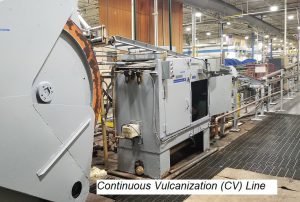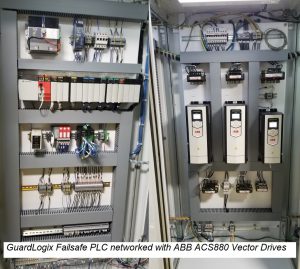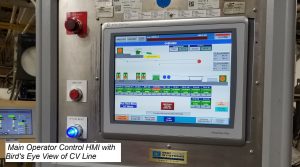 The oil and gas industry utilizes equipment and components that must perform and endure in harsh environments such as the ocean, underground, weather, and other adverse conditions. It is crucial that all equipment or materials used in such operations meet the highest quality standards and specifications. While many companies outsource the fabrication of large power cabling for these purposes, others fabricate internally for their own products and services for their customers. One such EDC customer in the oil and gas services industry manufactures many types of cable in-house.
The oil and gas industry utilizes equipment and components that must perform and endure in harsh environments such as the ocean, underground, weather, and other adverse conditions. It is crucial that all equipment or materials used in such operations meet the highest quality standards and specifications. While many companies outsource the fabrication of large power cabling for these purposes, others fabricate internally for their own products and services for their customers. One such EDC customer in the oil and gas services industry manufactures many types of cable in-house.

Of the assortment of products their plant produces, the most rugged, highest performing is a power cable that includes a rubberized outer jacket, made utilizing a process called continuous vulcanization – CV for short. In general, vulcanization is an industrial process in which rubber is hardened. Wire and cable manufacturers run their rubber-jacketed cables through a long steam-pipe catenary (think suspension bridge main cables) which cures the cable along the 300-plus foot-long tube. For a CV Line to work properly, an orchestra of extruders, pullers, motors, drives, sensors, valves and pumps must all work perfectly in concert.
While the cable manufacturer has been successfully producing CV cable for years, one of their three CV lines was experiencing excessive downtime and was scheduled for modernization.
PROBLEM
Apart from the expected aging and wear of production equipment, controls components such as drives, PLCs and other electronics suffer from the added issue of obsolescence. Whether functioning or not, an obsolete component such as an extruder AC variable frequency drive (VFD) puts continuous production in jeopardy.
The cable manufacturer had several obsolete components across a variety of automation manufacturers that made downtime even more harrowing. Years of purchasing refurbished or “gently used” components from eBay or surplus distributors had run its course. When a component was not able to be sourced, a replacement solution needed to be engineered to keep the line running.
In addition to overcoming the obsolescence issue, they wanted to take advantage of the many technological advances in industrial controls since the CV line’s construction, determined to upgrade to a world class, state-of-the-art production line.
SOLUTION
The cable manufacturer secured EDC’s turnkey integration services to give the line a full controls makeover. The upgrade featured a failsafe Rockwell GuardLogix PLC and a network of ABB ACS880 vector drives, HMIs, remote I/O and an industrial-hardened PC for data collection. The state-of-the-art controls network included:

- Rockwell GuardLogix 1756-L82ES Failsafe PLC CPU and I/O
- (5) Rockwell PanelView Plus 7 Performance HMIs, 7”-15”
- (11) ABB ACS880 VFDs, 3-200 hp
- (8) Rockwell 1734 series standard and failsafe remote I/O racks
- Lanner Fanless i7 PC with Rockwell Factory Talk SETM
- Tosibox Remote Access Module for remote monitoring and troubleshooting (EDC is located in New Jersey and the customer in Oklahoma!)
- Graceport with 115VAC convenience outlet and ethernet port for safe access to the machine network
Mechanical retrofits included swapping out Reeves drives with fixed gearboxes and VFD-controlled vector motors, sized for optimal speed range and torque. Caterpillar capstan motors and gearboxes were upsized to provide additional pulling capacity so larger cables could be run at higher line speeds.

EDC designed, manufactured, programmed, installed and commissioned the system. Operator training was provided, and the line turned over to the customer following execution and approval of a written Site Acceptance Test. A full documentation package included all schematics, drawings, programs and parts manuals.
IMPACT
During the Site Acceptance Test, their process engineers and maintenance personnel could immediately see an improvement on the line’s performance. It was much easier to adjust important process parameters, tighter tolerances were held throughout the product runs and higher quality cables were being produced. Operators with limited training could be qualified in a few hours to run the line, making it easier to find and retain them. New drives and PLC components meant no more late-night sourcing of obsolete components or outdated control methods. Because these key components were now networked together, vital information could be passed from the VFDs to the PLC and back to the operators at the user-friendly HMIs and on to the facility’s CimplicityTM plant historian. From their HMI screens, operators could now monitor line speed, steam pressure, and the speed of each drive.

Additional improvements at the HMIs included recipe functionality, contextual alarms and messages and streamlined set-up capabilities. One such streamline was the elimination of individual temperature controllers for the extruder barrel heater zones. The entire temperature control was moved into the PLC and the temperature setpoints featured as part of the recipes. Setting up one cable lot number to the next was nearly the touch of a button whether it was initiated on 1st, 2nd or 3rd shift – resolution of common pain point of shift-to-shift set-up (and quality) differences.
Other benefits included:
- Improved tension control between the Capstans
- Continuous data collection – allowing the customer to examine the data, see trends over time and adjust as necessary. Problems such as an out-of-range temperature or an oversized diameter can be pinpointed more quickly and accurately.
- Faster line speed – Conversion of communication protocols from hardwired to Ethernet-based results in a faster reaction to changes in tension, steam pressure, water level and speed ratios.
- More capability to fine-tune production – digital controls are more amenable to fine tuning and adjustments and not subject to drift.
- Overall improved safety – The failsafe PLC and VFDs with safe torque off capability ensure that the line can react to an E-stop quickly and reliably. Failsafe I/O meant elimination of long E-stop strings with the added benefit of knowing where and when an E-stop was triggered. Anti-tie-down features were added where two-hand controls were utilized.
- Full set of schematics with wire numbers and component references – previous control iterations did not include updated drawing or complete information. The customer’s maintenance department now has a full documentation package to help troubleshoot this line.
- Significantly reduced downtime – old, obsolete controls almost always lead to downtime and headaches. Upgrading to a world-class digital control system with late-model components that are readily available is a game-changer for any production facility.
“In addition to the efficiency gains, the modernization helped the client understand their process better,” says EDC Project Engineer Zach Fischer, who was the technical lead of this modernization project. “For example, if they see the tension increasing, to maintain the cable’s position in the tube they can take corrective action. The customer now has a wealth of information available to them via the much-improved operator interface.”
While EDC is happy with the success of the project and the many benefits attained by their customer, even more rewording are the words from a key member of the customer’s maintenance team,” I am impressed at how EDC resolved the tension issue with our capstans. They stood by their word and made it happen. I’d also like to add that when I need them it is so great to be able to get a person on the phone. I call in to their office, a live person answers their line, and I am able to speak to an engineer who assures me that they are working on my situation. With the Tosibox remote access module EDC can ‘see’ my CV Line from their office 1,000 miles away and help pinpoint and fix any issues. This gives me even more comfort.”
